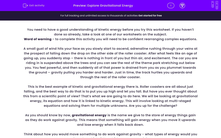You need to have a good understanding of kinetic energy before you try this worksheet. If you haven't done so already, take a look at one of our worksheets on the subject.
Word of warning - to complete this activity you will need to be confident rearranging complex equations.
A small gust of wind hits your face as you slowly start to ascend, adrenaline rushing through your veins at the prospect of falling down the drop on the other side of the roller coaster. After what feels like an age of going up, you suddenly stop – there is nothing in front of you but thin air, and excitement. The car you are riding in is suspended above the trees and you can see the rest of the theme park stretching out below you. You feel powerful, and then suddenly all of that power is drained from you as you plummet towards the ground – gravity pulling you harder and harder. Just in time, the track hurtles you upwards and through the rest of the roller coaster.
This is the best example of kinetic and gravitational energy there is. Roller coasters are all about just falling, and the best way to do that is to put you up high and let you fall. But have you ever thought about this from a scientific point of view? That’s what we are going to do here. We will be looking at gravitational energy, its equation and how it is linked to kinetic energy. This will involve looking at multi-staged equations and solving them for multiple unknowns. Are you up for the challenge?
As you should know by now, gravitational energy is the name we give to the store of energy things gain as they do work against gravity. This means that something will gain energy when you move it upwards and lose energy when it falls back down.
Think about how you would move something to do work against gravity - what types of energy would you have to put into it to get it to move upwards?
If you said kinetic energy, you would be correct! Kinetic energy and gravitational energy have a ‘special relationship’ where kinetic energy needs to be used to give something gravitational energy. The reverse is also true - if something loses gravitational energy, then it will gain kinetic! Now, because the world isn’t perfect, some of the energy lost from gravitational energy becomes wasted as heat from friction – but it’s a pretty good estimate! All you need to remember is that there is no such thing as a perfect system and some energy will be lost through friction wherever two objects touch. This is a favourite question of examiners – they love asking where the energy went – it is always lost as heat through friction.
So, what things will affect how much gravitational energy there is? Well, think of the things that will make it harder to lift an object up - there are three of them (two are obvious and one is a bit trickier).
1 The mass of the object. Okay – so this should make sense - the more massive the object, the harder it is to lift it up. So, that means that energy is proportional to the mass of the object.
Energy (E) ∝ mass (m)
2 The height you lift the object to. You have to use more energy to lift an object higher, so the higher the object travels, the more energy you need to use to lift that object. Let’s put that into our proportionality:
Energy (E) ∝ mass (m) x height (h)
3 Gravity - this is the tricky one. What if you were to lift that object up on the moon? Would it be easier or harder (assuming you have a spacesuit)? It would be easier because gravity is weaker on the moon than it is on Earth. So, the strength of gravity also affects the gravitational energy. If we put this into our equation, we get something that looks like this:
Gravitational energy = mass x gravitational field strength x height
E = mgh
Gravitational field strength will always be given to you in the question.
Now we have the equation, let's go through an example of how to use it:
An object falls a distance and gains 200 J of kinetic energy. Calculate the height the object fell from.
Mass of the object = 5 kg
Gravitational field strength on Earth = 9.8 N/kg
Step 1 Find all of the numbers you need and highlight them:
An object falls a distance and gains 200 J of kinetic energy. Calculate the height the object fell from.
Mass of the object = 5 kg
Gravitational field strength on Earth = 9.8 N/kg
Step 2 Write out the symbols with their numbers next to them:
REMEMBER, we said that kinetic energy and gravitational energy are linked, and if you lose one then you will gain the other. So, if we say that we gain kinetic, it has come from gravitational energy - that is 200 J.
E = 200 J
m = 5 kg
g = 9.8 N/kg
h = ?
Step 3 Rearrange the equation to make height the subject:
You do this by dividing by mass and gravitational field strength, leaving you with an equation that looks like this:
height = energy ÷ (mass x gravitational field strength)
Step 4 Put the numbers into the equation:
h = 200 ÷ (5 x 9.8)
Step 5 Put the numbers into the calculator and press = don’t forget the units.
h = 4.08 m
All done, let’s try out some questions!







